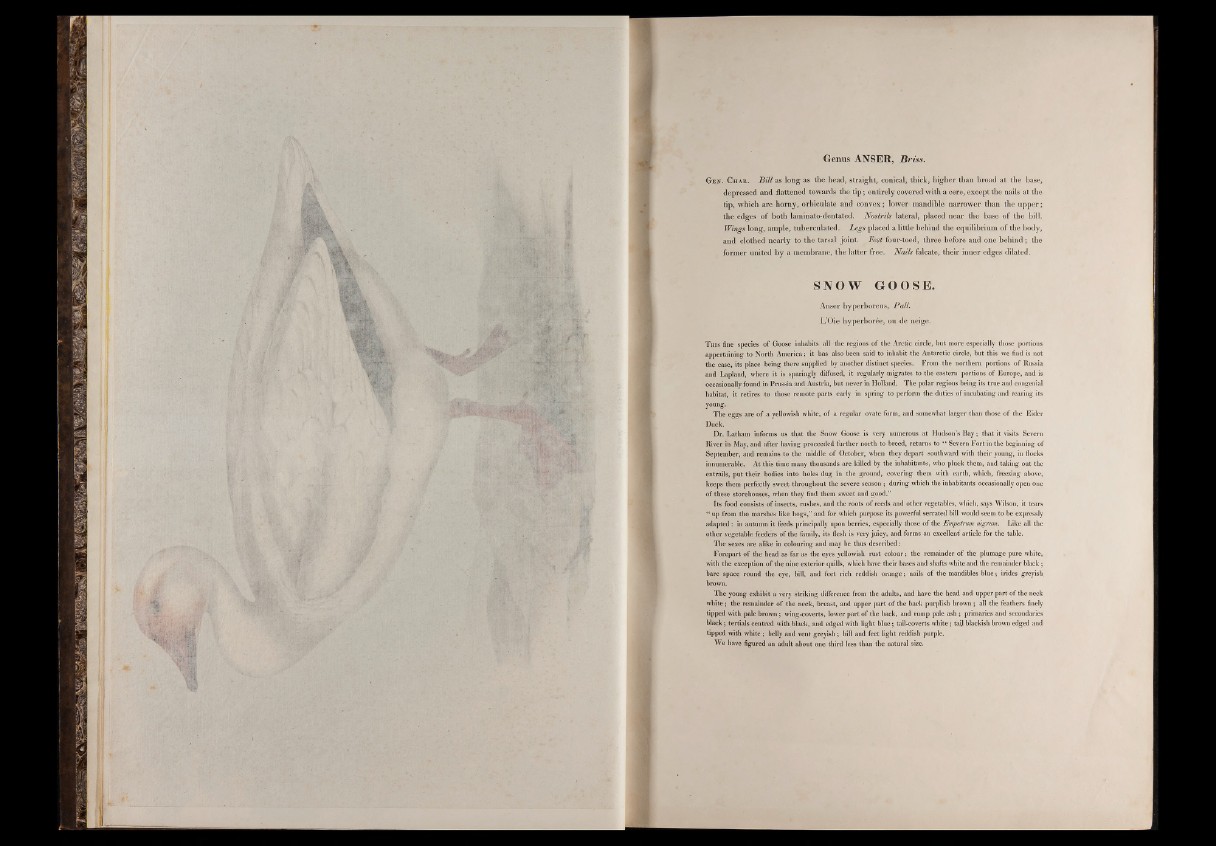
Genus ANSER, Briss.
Gen . C h a r . Bill as long as the head, straight, conical, thick, higher than broad at the base,
depressed and flattened towards the t ip ; entirely covered with a cere, except the nails at the
tip, which are horny, orbiculate and convex; lower mandible narrower than the upper;
the edges o f both laminato-dentated. Nostrils lateral, placed near the base o f the bill.
Wings long, ample, tuberculated. Legs placed a little behind the equilibrium o f the body,
and clothed nearly to the tarsal joint. Feet four-toed, three before and one beh in d ; the
former united by a membrane, the latter free. Nails falcate, their inner edges dilated.
SNOW GOOSE.
Anser hyperboreus, Pall.
L’Oie hyperbor6e, ou de neige.
T his fine species of Goose inhabits all the regions of the Arctic circle, but more especially those portions
appertaining to North America; it has also been said to inhabit the Antarctic circle, but this we find is not
the case, its place being there supplied by another distinct species. From the northern portions of Russia
and Lapland, where it is sparingly diffused, it regularly migrates to the eastern portions of Europe, and is
occasionally found in Prussia and Austria, but never in Holland. The polar regions being its true and congenial
habitat, it retires to those remote parts early in spring to perform the duties of incubating and rearing its
young.
The eggs are of a yellowish white, of a regular ovate form, and somewhat larger than those of the Eider
Duck.
Dr. Latham informs us that the Snow Goose is very numerous at Hudson’s Bay; that it visits Severn
River in May, and after having proceeded further north to breed, returns to “ Severn Fort in the beginning of
September, and remains to the middle of October, when they depart southward with their young, in flocks
innumerable. At this time many thousands are killed by the inhabitants, who pluck them, and taking out the
entrails, put their bodies into holes dug in the ground, covering them with earth, which, freezing above,
keeps them perfectly sweet throughout the severe season ; during which the inhabitants occasionally open one
of these storehouses, when they find them sweet and good.”
Its food consists of insects, rushes, and the roots of reeds and other vegetables, which, says Wilson, it tears
“ up from the marshes like hogs,” and for which purpose its powerful serrated bill would seem to be expressly
adapted: in autumn it feeds principally upon berries, especially those of the Empetrum nigrum. Like all the
other vegetable feeders of the family, its flesh is very juicy, and forms an excellent article for the table.
The sexes are alike in colouring and may be thus described:
Forepart of the head as far as the eyes yellowish rust colour; the remainder of the plumage pure white,
with the exception of the nine exterior quills, which have their bases and shafts white and the remainder black ;
bare space round the eye, bill, and feet rich reddish orange; nails of the mandibles blue; irides greyish,
brown.
The young exhibit a very striking difference from the adults, and have the head and upper part of the neck
white; the remainder of the neck, breast, and upper part of the back purplish brown ; all the feathers finely
tipped with pale brown ; wing-coverts, lower part of the back, and rump pale ash; primaries and secondaries
black; tertials centred with black, and edged with light blue; tail-coverts white; tail blackish brown edged and
tipped with white; belly and vent greyish; bill and feet light reddish purple.
We have figured an adult about one third less than the natural size.